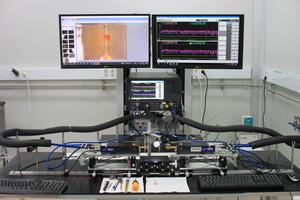[ad_1]
#Korean The government aims to commercialize 6G by 2028, and has invested a total of 1 trillion won in related research, and interest in frequencies for 6G is increasing. However, the lack of electromagnetic measurement standards in the sub-terahertz frequency range, which is a promising candidate for 6G, makes it difficult to verify technical reliability.
The Korea Institute of Standards and Science (KRISS, President Park Hyun-min) has developed electromagnetic wave measurement standards for 6G candidate frequency bands.
The newly developed standard concerns electromagnetic impedance* It is a D-band (110-170 GHz) frequency band and is a promising candidate frequency band for 6G. It is one of the most important standards among electromagnetic wave measurement standards, and serves as a standard for performance evaluation in fields where electromagnetic waves are used, such as communications and defense.
*Impedance: A basic value in electromagnetic wave measurement, representing the amount of resistance when electromagnetic waves propagate.
The frequency bands to be used for 6G have not yet been decided. However, generally speaking, the higher the frequency, the wider the communication band, so high frequency ranges are considered suitable for high-speed transmission of large amounts of data. This is similar to how a 16 lane road can handle more traffic than his 2 lane road.D-band frequency corresponding to sub-terahertz** It is a frequency band that covers the widest range among high frequency bands, and is attracting attention as a candidate frequency for 6G. This is because losses due to water vapor and oxygen are minimized, and large amounts of signals can be uniformly transmitted over a wide range over large distances.
** Subterahertz: A frequency range from 100 to 300 GHz, which is attracting attention as a candidate frequency for 6G that can transmit 1 TB per second.
KRISS’s electromagnetic wave measurement group has established the third D-band electromagnetic wave impedance measurement standard in the world after Japan and Germany. International equivalence is also ensured through comparison with Germany. This is the first international comparison of impedance measurement standards above 110 GHz.
The primary frequency range for 5G communications is below 30 GHz, and established electromagnetic measurement standards are limited to frequencies below 110 GHz. Even when 6G-related parts and parts that can be used in D-band and above were developed, there was a lack of standards for evaluating performance.
The development of the new standard will enable reliable verification of the performance of various 6G-related components and parts. This standard applies not only to 6G but also to all fields that use D-band frequency electromagnetic waves, such as defense radar systems.
KRISS has developed a unique D-band impedance calibration device to distribute newly developed electromagnetic standards to the industrial sector. Previously, circuit analyzers used for impedance measurements had to be calibrated with expensive imported devices. However, this widespread use has made it possible to provide industry with more accurate measurement standards at a significantly reduced cost.
Dr. Kwon Jae-young, head of the electromagnetic wave measurement group, said, “The development of new standards and the domestic production of calibration equipment will help ensure international trust in Korea’s domestic 6G technology.” We will establish additional electromagnetic metrics such as RF power, attenuation, and antennas, and continue tracking studies up to the 300GHz frequency band to enable stable adaptation to 6G. ”
Such follow-up research has not yet been considered internationally, and KRISS’s electromagnetic measurement group has received proposals for cooperation from major countries such as Germany and the United States. KRISS expects to work closely with industrial and academic partners such as LG Electronics and KAIST to continue research to ensure Korea’s leadership in 6G technology.
###
With support from KRISS, the research results were published in an international journal. IEEE Transactions on Metrology and Metrology (IF: 5.6) July 2023.
Disclaimer: AAAS and EurekAlert! We are not responsible for the accuracy of news releases posted on EurekAlert! Use of Information by Contributing Institutions or via the EurekAlert System.
[ad_2]
Source link


